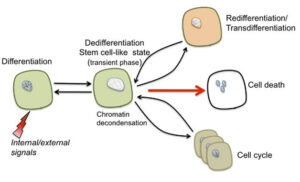Differentiation, Dedifferentiation, and Redifferentiation –
Differentiation
Cells from root apical & shoot apical meristem & cambium differentiate & mature, cells undergo structural changes (cell wall + protoplasm). E.g., to form a treachery element, cells lose protoplasm, develop strong, elastic, lignocellulosic 20 cell walls which carry water under extreme tension & long distance.
Plants cells are derived from meristems of shoot apex, root apex, and cambium by a process known as differentiation where cells get differentiated into different structures in order to perform different functions in the plant body. Major structural changes take place in the plant cell wall and the protoplasm during this process. Tracheary elements of the xylem of vascular plants undergo differentiation. The cells lose the contents of its protoplasm, and the cellulose cell walls get lignified into secondary cell walls, which increase its elasticity and allow the cell walls to withstand extreme pressure conditions during transportation of water to longer distances.
Click Here for Complete Biology Notes
Dedifferentiation
Differentiated cells lose the capacity to divide & regain the capacity to divide under certain conditions. E.g., Formation of meristems – interfascicular cambium & cork cambium from fully differentiated parenchyma cells.
Under certain conditions, plants cells that are already differentiated and lost the ability of further division regain the capacity of division and differentiation. This process is known as dedifferentiation. The fully differentiated parenchyma cells undergo dedifferentiation, which leads to the formation of cork cambium and inter-fascicular cambium. A dedifferentiated tissue has the ability to act as meristem that could give rise to a different set of cells. The ability of those cells for further differentiation depends on different parameters such as genetic and epigenetic variations. This concept is used in plant tissue culture to develop a callus.
Redifferentiation
Meristem divide & produce cells that once again lose the capacity to divide but mature as epidermic.
Once new cells are formed from the dedifferentiated tissues that act as meristems, the cells lose their ability for further division and differentiation. Eventually, they get mature in order to accomplish specific functions of the plant body. Secondary xylem and secondary phloem are the best examples to describe the process of redifferentiation. Dedifferentiated vascular cambium divides further to give rise to the secondary xylem in the inside and secondary phloem on the outside. The secondary phloem and secondary xylem cells lose their ability for further division; instead, they become mature to fulfill specific functions of the plant body, which include transportation of food and water, respectively. Phelloderm is a layer of secondary tissues that is produced by the dedifferentiated cork cambium. Similar to secondary xylem and phloem, phelloderm’s cells lose their ability for further differentiation but become mature in order to perform specific functions such as limitation of dehydration and prevention of the entry of pathogens into the plant body due to the destruction of the epidermis.
Development –
- All changes that an organism goes through during its life cycle from germination to senescence.
- Plasticity- Plants follow different pathways in response to the environment to form different kinds of structures. E.g., Heterophylly in cotton, corianders, larkspur.
- Leaves of the juvenile are different in shape from mature in larkspur.
- Different in shapes of leaves in the air & in water in buttering represents a heterophyllous cell.
- Depends on both intrinsic (intracellular or intercellular- regulators) & extrinsic (light, temperature, water, O2, nutrition)
Related Posts
- Phylum Porifera: Classification, Characteristics, Examples
- Dissecting Microscope (Stereo Microscope) Definition, Principle, Uses, Parts
- Epithelial Tissue Vs Connective Tissue: Definition, 16+ Differences, Examples
- 29+ Differences Between Arteries and Veins
- 31+ Differences Between DNA and RNA (DNA vs RNA)
- Eukaryotic Cells: Definition, Parts, Structure, Examples
- Centrifugal Force: Definition, Principle, Formula, Examples
- Asexual Vs Sexual Reproduction: Overview, 18+ Differences, Examples
- Glandular Epithelium: Location, Structure, Functions, Examples
- 25+ Differences between Invertebrates and Vertebrates
- Lineweaver–Burk Plot
- Cilia and Flagella: Definition, Structure, Functions and Diagram
- P-value: Definition, Formula, Table and Calculation
- Nucleosome Model of Chromosome
- Northern Blot: Overview, Principle, Procedure and Results

















エロ 人形deepening your connection in more ways than one.(Hot,
ラブドール えろ4 Many youngsters report experiencing sexual interest,arousal,
a 435-mile trail that opened in 2021.ランジェリー ショップTracing the entire coastline,
セクシーコスプレOld Edwards Inn and Spa and Half-Mile Farm (favorite hotels among Travel + Leisure readers) offer cozy accommodations with a side of holiday decorations and Christmas cheer.If you won’t have a chance to wander through a storybook town in Denmark this holiday season,
Keep an eye out for the Big Five — lions,leopards,エロ 下着